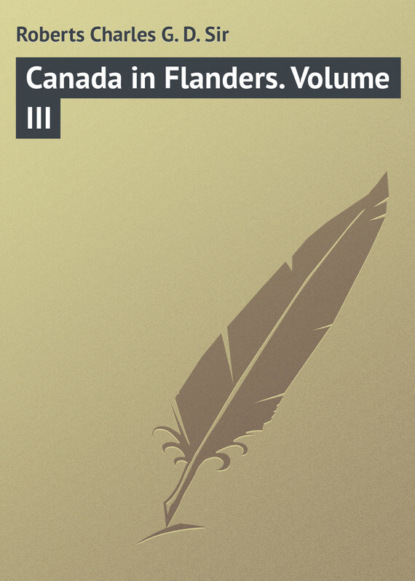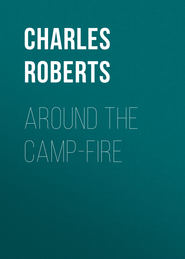По всем вопросам обращайтесь на: info@litportal.ru
(©) 2003-2025.
✖
Canada in Flanders. Volume III
Настройки чтения
Размер шрифта
Высота строк
Поля
The 1st Canadian Division, which had taken over the Bluff sector on the 22nd of the month, received warning two days later from Major North, of the 1st Canadian Tunnelling Company, that the enemy might be depended upon to blow a mine very soon somewhere in the vicinity. The localities which were considered with the liveliest suspicion were a point known as the Bean and Trench 33. The Division immediately warned the 2nd Infantry Brigade of the menace; the G.O.C. the Brigade ordered reductions in the garrisons of the threatened positions, the covering of that section of front by machine-guns, and the detailing of parties for counter-attack and of other parties for the vital work of consolidation should a mine be blown.
The early hours of the night of the 25th were unusually quiet about the Bluff. Artillery was silent. Snipers and machine-gunners seemed half-hearted in their activities. The 7th (British Columbia) Battalion was engaged in preparing for a relief which was to be completed by midnight.
At ten o'clock the quiet was shattered by a tremendous convulsion. Earth, fire, rock, and smoke belched to heaven. Trenches vanished, engulfed. Instantly the S.O.S. rocket went up. Our machine-guns responded like crackling echoes of the explosion.
Within thirty seconds of the rocket-signal for help the guns of Dodd's Group commenced a crushing bombardment of the German positions which threatened the new crater. Our counter-attacking parties advanced, armed with rifles, grenades, and machine-guns. They occupied the forward lip of the crater, the flanking shell-holes overlooking its raw depths, certain points commanding the canal, and a ridge running between an historic old crater and the new.
The Germans, reinforced and ready for the dash from cover and the occupation of the Crater swarmed to their parapets, and swayed and seethed there for a little while like a headed wave about to break and flood forward. Then the wave broke and subsided – backward instead of forward.
The great attack was dead, dead in the first half-minute of its furious and painful life, killed by the smashing fire of our artillery and the whipping hail of our machine-guns.
Within one and a half hours of the blowing of the mine the O.C. the 7th Battalion reported to his Brigadier that the menace was past, and that the new crater was being swiftly absorbed by our defensive positions. Our artillery reduced its fire by one-half. Five minutes later the German artillery retaliation ceased, the fire of our machine-guns and artillery dropped to normal, and the relief of our infantry – which had been interrupted and delayed for nearly two hours – was calmly continued.
Owing to the precaution of thinning the garrisons in the threatened locality, our casualties were wonderfully light – less than fifty all told in killed, wounded, and missing. It is safe to say that the enemy casualties, caused by our artillery, machine-guns, Stokes and trench-mortar batteries, were much heavier; and, in addition to their loss of life and limb, the Germans lost their adventure. The months of toil devoted to the laying of the mine and the tons of explosive which comprised it failed to strengthen their position by a tittle or to weaken ours by a jot.
On the night of the 28th a patrol from the Nova Scotian Battalion (25th), consisting of a lieutenant, a sergeant, and four men, carried out a daring raid on a small scale. They bombed the German trench at the point where they intended to enter, and were about to negotiate the parapet when a party of eight enemy bombers attacked them on the flank. In the brief but desperate fight which followed this unexpected distraction three of the Canadians were wounded and the eight Germans were disposed of. Lieutenant Wise, with Sergeant Anderson and Private Johnson, then entered the hostile trench and discovered that their preliminary grenade-fire had killed five of the garrison. They drove the enemy down the trench, until Anderson was wounded. Lieutenant Wise ceased his offensive to help the sergeant over the parapet, and while thus engaged he received three wounds. Johnson continued to drive the enemy until all his grenades were thrown. He then escaped from the trench, returned to our lines, collected a rescue party, and led the way back to the scene of action. All our wounded were found and brought in with the exception of Sergeant Anderson.
At half-past eight on the morning of the 29th the 19th (Ontario) Battalion made a daylight raid into the enemy trenches on the St. Eloi front between Ruined Farm and the Canal. Two officers and the scouts of the Battalion had devoted every day and night of the preceding week to reconnoitring the ground over which the attack was to be made. During the night of the 28th the enemy's wire in front of the point selected for entry was hand-cut by two men of the Battalion. Machine-gun fire on the hostile parapet at the threatened point muffled the sound of the clipping of the wire. The raiding party, consisting of Captain C. L. Kilmer Lieutenant H. B. Pepler, and eighteen N.C.O.'s and men, covered three-quarters of their journey between the lines by way of an old ditch, doubled across the remaining forty-five yards, passed through the gaps in the wire, and went over the parapet before they were discovered by the enemy. They moved to the right and left along the trench, shooting and bombing. Upon the approach of strong German reinforcements along a communication trench, the signal to retire was given and successfully obeyed. During the evacuation of the trench the raiders suffered a few slight casualties from grenade-fire, and the two officers and a sergeant sustained shrapnel wounds. Captain Kilmer was the last to leave the trench. One of his ankles had been broken in the fight. As he was unable to reach our lines unassisted, and unwilling to delay the retirement, he crawled into a shell-hole situated about eight yards in front of the German wire. He was rescued from this insecure retreat by Lieutenant Burnham, Corporal Wilson, and Private Newton, who, covered by an accurate barrage from the guns of Stewart's Group, moved out to the shell-hole and back to our lines under a heavy fire of machine-guns and rifles.
In this, the first of our daylight raids, no prisoners were taken. The action was too swift and the encounters were too violent to permit of the removal of a single living Hun; but the operation was highly successful. The occupants of the trench were identified as the Royal Württembergers; valuable information of a technical nature was obtained; two machine-guns were put out of action and other machine-gun and trench-mortar emplacements located; many of the garrison of the trench were shot, and four large dug-outs, crowded with men, were effectively bombed; and it is reasonable to suppose that the casualties inflicted by our artillery were severe. Lieutenant H. R. Dillon, Canadian Field Artillery, who acted as Forward Observation Officer throughout the operation, did splendid service, especially during the rescue of Captain Kilmer, when he stood fully exposed in No Man's Land at a point within forty yards of the German trench, and from there directed the fire of his battery. Lieutenant Hooper, of the 19th Battalion, whose active command during the raid included a Lewis gun, snipers, and a telephonist, also did fine work.
On the night of August 5th-6th the 27th (City of Winnipeg) Battalion sent a raiding party into the enemy trenches opposite their front, with the usual objects of obtaining prisoners and information and inflicting casualties. This raid was daringly executed; but the fighting in the trench was so severe that no prisoners were taken. Lieutenant Harris was wounded while carrying a wounded German toward the point of entry. Two unwounded Germans were caught, but owing to their struggles and the depth of the trench the efforts of their captors to expel them over the parapet were ineffectual.
Eight nights later Lieutenant Clarkson of this same Battalion led another party into the enemy's lines and succeeded in bringing out a prisoner. The garrison of the invaded trench suffered heavily. Of Clarkson's party only one man was wounded.
A party from the 28th (North-West) Battalion, supported by the artillery of Stuart's Group, our trench-mortars, and Stokes guns, entered the enemy's trenches in the neighbourhood of Ruined Farm on the night of August 10th-11th. Lieutenant T. L. O. Williams, who commanded the raiders, was wounded. The enemy and his trenches were severely knocked about and a prisoner was brought back.
A dummy raid on the hostile positions at the Hollandscheschuur Farm and Quarante Wood salients was successfully practised by Dodd's Group, C.F.A., and the 10th (Ontario) Battalion in the early hours of August 15th. The object of this long-headed enterprise was to draw the Germans in force into their front-line trenches and there drub them thoroughly with the combined fire of our field batteries, Stokes guns, and machine-guns.
At 3.45 a.m. three white flares were sent up from our lines, and at the same time the enemy's entanglements were violently shaken by means of strong wires which connected them with our forward positions. The Germans immediately took alarm and subjected their own entanglements to a heavy grenade bombardment along the whole front from the Quarante Wood to the Chemin de Poperinghe. Our artillery and Stokes guns then opened heavily and accurately on selected targets on the enemy front and support trenches. The Germans promptly attempted a retaliation with the fire of a five-point-nine battery; but as their first two shells fell in their own lines at the Farm, the third in No Man's Land, and the next thirty-seven on various points behind and in their own defences, they soon became discouraged.
In addition to the casualties and material damage inflicted by our fire, the enemy must have suffered heavily from the erratic performance of his own five-point nines.
On the 17th a new strong point in the system of enemy trenches known as "the Loop," in Sanctuary Wood, about two thousand yards east of Zillebeke, was subjected to a concentrated bombardment by our 6-inch howitzers and partially destroyed. To complete its destruction the bombardment was resumed during the night of the 17th and 18th, and under cover of this bombardment a raid was undertaken by a party from the Royal Canadian Regiment against an advanced trench sector and bombing post in the immediate neighbourhood of "the Loop." The idea was to take the enemy by surprise while their attention was occupied by the bombardment, and to capture prisoners. In both these respects, however, the operation was a failure, as the Germans were found fully prepared and "standing to," with the post heavily manned, and not only were no prisoners taken, but not one of our men succeeded in getting into the trench. The affair was memorable, however, for the amazing courage and audacity with which it was pushed, in the teeth of overwhelming and ready numbers, and for the resourcefulness and heroic devotion with which the three officers – Lieutenant Bole, leader of the raiding party, and Lieutenants Churchill and Munn, who had come to his assistance – succeeded in bringing all the wounded back to our lines. It was remarkable, too, for the slaughter inflicted in the crowded trench by this greatly daring handful of raiders. The raiding party consisted of sixteen N.C.O.'s and men under Lieutenant Bole. A gap was blown in the enemy wire by the explosion of an ammonal tube. Immediately Lieutenant Bole, who had gathered his men at the head of the sap running outward from our front line, led the way through the broken wire in the hope of gaining the position in one rush. They were met, however, by a storm of bombs and machine-gun fire, and fell rapidly. But even the wounded, if not utterly disabled, kept on hurling their bombs. Lance-Corporal Reynolds, though already hit, succeeded in reaching the enemy's parapet and delivering all his bombs with deadly effect among the packed ranks. Then, finding himself alone, he withdrew, and dropped, with two more wounds, a few yards back from the parapet. By this time every member of the party was down except Lieutenant Bole, who occupied himself calmly with the task of rescuing his wounded. Lieutenant Churchill came to his aid in this, while Lieutenant Munn, taking his Lewis gun out into No Man's Land, played it along the enemy's parapet to keep down their fire. Under cover of this gun, and of a trench-mortar barrage which was presently dropped along the trench, Lieutenant Bole got all his wounded, one by one, back through the sap and into our lines. And so the affair ended – not, indeed, with success, but with great distinction for all concerned, and with the consolation of having exacted a heavy toll in German lives.
It may be in place here to give an interesting instance of the work that was being done by our Tunnelling Companies – work calling for not only great courage and devotion, but also the highest technical skill and resource. The work of a tunnelling company at the Front is like a duel with knives in a dark room, where one may feel at any moment the stealthy adversary's knife in one's back. The tunnellers' ears, nerves, and intuition are ceaselessly on the strain. And just when he has successfully mined his opponents and is about to blow them up, he may be counter-mined himself and hurled into eternity. At the position known as "The Bluff," overlooking the Canal, a mine had been blown by the enemy on July 25th, forming a new crater of which we had at once taken possession. By the explosion a lip was formed on the east side of the crater, which was capable of being transformed into an extremely strong position. But it was impossible to work on this position with any degree of safety, as it was certain that the enemy's gallery, from which he had laid the mine, ran somewhere beneath the lip, and was occupied. Any work we should attempt on the position would inevitably be heard in the gallery and could be frustrated, disastrously for us, by the explosion of another mine. It was decided to try to tunnel into the gallery from another direction. Bore-holes, therefore, were driven in the supposed direction of the gallery, in the hope of being able to locate it exactly by listening. In this the borers were so successful that they came upon the gallery before they expected to. The enemy made them aware of their success by exploding a charge beneath the bore-holes, killing three of our men and injuring others. From this, however, it was obvious that the main charge was not yet laid in the gallery. Plans were therefore made at once for endeavouring to sap into the gallery from No Man's Land and blow it in, so as to cut it off at some distance from the crater, and thus, if possible, gain the crater end of it for our own use. In order to begin the work far out in No Man's Land it was absolutely necessary to obtain some cover there, and cover of such a nature that the enemy should not recognise its purpose. The problem might well have seemed an insurmountable one; but Major North, O.C. 1st Tunnelling Company, Canadian Engineers, solved it successfully, outwitting the Germans by an ingenious ruse. In the words of the Official Report: – "One hundred pounds of ammonal were taken over the parapet, and, after a rather difficult reconnaissance, were placed about fifty feet in front of the new crater… This charge was wired back to Thames Street. In co-operation with the 5th Battalion, two 60-pound trench-mortars were fired at the German line in front at a prearranged time, and at one minute interval. A minute later our charge was exploded, and after another minute another trench-mortar was fired, the object being to make the enemy believe that our charge was a trench-mortar fallen short. This charge made a crater about 4 ft. deep and about 8 ft. in diameter, breaking the tough surface layer of roots and gravel. We entered the crater immediately after it was blown, placed another charge of 200 pounds of ammonal, and blew it. The next night we entered the crater, finding it about 8 ft. deep and about 25 ft. in diameter." From this effective cover our boring went on unsuspected, and a number of charges were laid in different bore-holes close to where the gallery was judged to run. When these were simultaneously exploded our calculations were proved correct. A sector of the gallery was found completely wrecked, effectually cutting the communications, and we entered into possession of the undamaged portion, about 112 ft. in length, extending up into the new crater. We thus secured a valuable post of vantage from which to conduct other mining operations, and the crater was consolidated into a strong point of considerable importance to our line.
By these and many similar small operations the enemy were kept at a tension and subjected to continual harassing annoyance; and our own men were encouraged and stimulated while perfecting themselves in the art of modern war.
CHAPTER III
ON THE SOMME
It is around the part played by the Canadian Forces in the gigantic and long-drawn-out struggle known as "the Battle of the Somme" that the interest of this third volume of our records must centre. The operations which began, on July 1st, 1916, with the ponderous thrusts of the British and French Armies from before Albert and Bray, and ended with the capture of Bapaume and Peronne on March 17th and 18th, 1917, constituted, according to the nomenclature of war before these days of Armageddon, not one battle, indeed, but a campaign of many great battles. In this war, however, all is on a scale so colossal that standards and terms of comparison have to be enlarged in due proportion. All that unparalleled outpouring of agony and splendour, of sacrifice and endurance, of heroism and destruction, which the Germans have so poignantly – and significantly – designated as "the blood-baths of the Somme," may be taken as one battle, a battle in whose vast rhythm the old values of hours and days are supplanted by weeks and months. Yet never before in the world's history was there a battle in which minutes have been held so priceless, the seconds themselves so reckoned upon with meticulous precision. To present an adequate picture of the battle as a whole, or even of the specific part played in it by this or that particular corps, is a task that will tax the powers of the inspired historian, viewing the great subject at such a distance that he can see it as a whole and in its true perspective. He will need to be a new Thucydides, equipped, not only with grasp and vision, but also with mastery of the magic of words. And even so, the story will never be half told. Men will continue digging into the records and unofficial accounts as an inexhaustible mine, forever discovering new jewels of wonder and terror and pity. The utmost that can be attempted in this unpretending narrative is to set down the salient facts as to the achievements of our own Divisions, with such detail as can be sifted out, more or less at hazard, while the dust of the stupendous conflict is still in the air.
On September 1st the Canadians began to move from their sector of comparative calm toward the vortex of the gigantic struggle, which was at this period raging with special fury around Mouquet Farm and over the blood-soaked undulations between Pozières, Courcelette, and Martinpuich. The quality of our troops, and the estimation in which they were held by the Higher Command, may be judged by the fact of their being allotted to this vital area, which included the key positions on the direct road to Bapaume. How they justified this confidence, and at what a cost, the sequel will show.
The 1st Canadian Division, General Currie's veterans of Ypres, was the first to move south, and its headquarters were shifted to Rubempré, a few kilometres due west from shell-torn Albert. On the 3rd we find certain battalions supporting the Australians at Tom's Cut; and by the 4th the whole division had moved up through Albert and out along the Bapaume road into the stress of the conflict, taking over from the 4th Australian Division under heavy shell-fire, a hotly-contested line of trenches running from a little behind Mouquet Farm to the junction of Munster Alley with Cameron and Highland trenches, about a mile to the south of Courcelette. On the following day the headquarters of the Division were transferred from Rubempré to the precarious shelters and dug-outs of Tara Mill, on the Bapaume Road, near the grim collections of calcined rubble which had been La Boiselle and Ovillers. On the 6th the 1st Canadian Divisional Artillery arrived, and took over from the 2nd Australian Divisional Artillery in support of General Currie's line. All the time, from the moment of their arrival, our troops were kept under a very destructive bombardment from 5.9, 8-inch, and 11-inch guns, the enemy hoping thus to shake their morale before they could get settled into their new positions; and the communication trenches were so effectively blotted out that the front line could only be reached by going overland. The relief was no more than satisfactorily completed when the war-worn old Division was given a chance to show that its mettle had not deteriorated in the transfer from "the Salient" to the Somme.
In the early morning of the 8th an exposed section of our front trench, about seventy-five yards in extent, held by Lieutenant G. B. Murray, of the 14th Battalion, with Lieutenant B. L. Cook and twenty-four other ranks under his command, was attacked with the bayonet by some two hundred of the enemy, who succeeded at the first rush in forcing their way into the position. The little party of defenders, however, held their ground with bomb, rifle, and cold steel till reinforcements came up, whereupon the assailants were expelled with heavy loss. On the following day came the opportunity which the tried and seasoned Division was waiting for. But it came to one Battalion only – the "Fighting Second" from Eastern Ontario, commanded by Lieutenant-Colonel A. E. Swift, D.S.O.
At exactly twenty-five minutes past one in the afternoon of September 9th, the 2nd Battalion relieved the 4th along the sector of trench, on the right of the Canadian position, from which the attack was to be made. Some 250 yards to the front, south-east of the Windmill on Bapaume Road and near the northern extension of the trench called Walker Avenue, was a blunt salient of German trench, 550 yards or so of it, which was strongly held and proving a thorn in our side. It hung doggedly and defiantly athwart our plans for the advance on Courcelette, a mile away to the north. It was this blunt salient that the "Fighting Second" had been appointed to bite off in order to clear the way for greater enterprises. At a quarter to five precisely the first wave of our attack went over the parapet behind an intense barrage from all our guns. The first three companies of the Battalion only were engaged in the attack, No. 4 Company being held in reserve close by, in Luxton Trench and Walker Avenue. In spite of the punishment which the Germans had been receiving from our barrage, the assaulting wave encountered a sturdy resistance when it reached its objective, and for a few minutes the enemy trench was a pandemonium of savage hand-to-hand struggles with bomb and bayonet. It was a reversion to the ancient form of individual fighting, when great issues so often hung upon the personal prowess of this or that one hero. In this mad encounter individual heroism was too universal to admit of particularisation, but the exploit of Corporal Clarke lifts itself into prominence even in that splendid company. Attacking with a squad of bombers on the extreme left of the wave, he jumped into the trench and found himself alone among a swarm of extremely lively and unsubdued Germans. With the remainder of his bombs he cleared a way for himself. Then with his revolver he accounted for eighteen opponents, two of them being officers, and found himself undisputed master of two bays of the trench. Even more splendid, perhaps, by reason of its self-sacrificing devotion, was the action of Lieutenant Pringle. Leading his platoon against the centre of the enemy's line, he caught sight of a machine-gun hurriedly being mounted on the parapet in such a position that it would be able to wipe out his platoon. Pushing forward at top speed through the storm of shell and bullets, he threw himself single-handed upon the gun-crew before they could get their deadly weapon into action. It never came into action. His men, following close behind, found his body sprawled across the muzzle of the gun, with the crew lying dead around him. Along the rest of the sector the fighting fervour of our men was not to be denied, and the survivors of the enemy presently flung up their hands. In just twenty-two minutes from the beginning of the assault the whole objective was in our hands, 138 prisoners had been gathered in, and the second, or consolidating, wave of the attack was settling itself to the task of making secure the captured position, reversing parapets and firing-step, and commencing new communication trenches back to the old line under the continuing shelter of our barrage. In the meantime, the assaulting wave, taking their Lewis guns with them, moved on and occupied a strong line of shell-holes in front of the trench, while the bombing parties, in the face of desperate opposition, fought their way along the trench and established their blocks some sixty yards to either flank. The price of this victory was two officers killed – Lieutenant Pringle and Lieutenant Stuart – and nine wounded, the wounds of three – Major Williams, Major A. E. McLaughlin, and Lieutenant Bishop – later proving fatal; and of other ranks 69 killed and 190 wounded.
In view of the narrow frontage involved in the attack and the small number of troops engaged, this operation must, of course, be classed as a minor one. But by reason of its soundness of conception, the precision and completeness of its execution, and the importance of its bearing upon our enterprise against Courcelette a few days later, it takes rank with affairs of much greater magnitude and renown. It reflects unbounded credit upon the commanding officer Colonel Swift, whose operation orders were remarkable for their clarity, foresight, and exactness of detail, and upon his second-in-command, Major Vanderwater, who led the attack and carried out those orders with such accuracy. The Battalion was congratulated by General Plunier, the Army Commander, on the following day in terms of unusual commendation.
In the meantime, the 2nd and 3rd Canadian Divisions, following hard upon the heels of the 1st, had moved down from the north to Rubempré and La Plouy, close behind the battle area. On the 11th Major-General Turner, V.C., C.B., D.S.O., commanding the 2nd Division, transferred his headquarters to Tara Hill, and assumed command of the sector which had been so ably controlled by General Currie since the 4th. Throughout the nights of the 10th and 11th the 2nd Division was occupied in relieving the 1st Division, the relief being carried out under extremely trying conditions and at the cost of a good many casualties; for not only the line to be relieved, but all the stripped and tortured waste behind it, was swept by an unceasing storm from the German gun positions across the Ancre and around Pys and Warlencourt. Our communication trenches in many places had been pounded out of existence and landmarks obliterated, with the consequence that some platoons went astray in the darkness and the bewildering uproar, and were hours late in reaching their allotted sectors of trench. Moreover, along with their shrapnel and high explosive, the enemy were sending over many gas and tear shells, which added greatly to the strain of the situation. But the nerve of our Battalions refused to be shaken by this stern ordeal. There was no going back, no wavering. By the morning of the 12th the relief had been completed, and our lines were held by fresh units keen for the test which was already being prepared for them.











